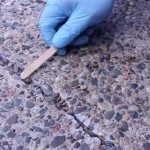How To Get Rid Of Ants In Patio Pavers
Ants infiltrating patio pavers are a common nuisance for homeowners. These tiny insects can establish colonies beneath the pavers, creating unsightly mounds of sand and disrupting the aesthetic appeal of the outdoor space. Furthermore, their presence can lead to structural issues as they undermine the paver foundation. Effective ant control requires understanding their behavior, identifying the infestation's specific location, and implementing a combination of preventive measures and targeted treatments. This article provides a comprehensive guide on how to eliminate ants from patio pavers and prevent their return.
Identifying the Ant Species and Extent of the Infestation
Before embarking on any treatment plan, it is crucial to identify the ant species causing the problem. Different ant species exhibit varying behaviors and preferences, which directly impacts the effectiveness of chosen control methods. Common types of ants that infest patio pavers include pavement ants, Argentine ants, and carpenter ants. Pavement ants are small, dark-colored ants that nest in cracks and crevices of pavement and sidewalks. Argentine ants are small, brownish ants that are highly adaptable and can quickly establish large colonies. Carpenter ants, while primarily known for their wood-destroying habits, may also nest under pavers, especially if there is decaying wood nearby.
Species identification can often be done by observing the ants' physical characteristics, such as size, color, and body shape. Observing their behavior, such as their foraging trails and nesting habits, can also provide clues. Online resources and local pest control professionals can assist in accurately identifying the ant species. Accurate identification is critical because certain treatments are more effective against specific species. For example, baiting systems work well for Argentine ants, while direct contact sprays may be more suitable for pavement ants.
Assessing the extent of the infestation is equally important. Look for ant mounds between pavers, ant trails leading to and from the patio, and any signs of structural damage, such as shifting or uneven pavers. Check for ant activity during different times of the day, as some species are more active at night. A thorough inspection will help determine the severity of the problem and guide the selection of appropriate treatment strategies. Smaller infestations may be manageable with DIY methods, while larger or more persistent infestations may require professional intervention.
Implementing Preventative Measures
Preventing ant infestations is often more effective and less invasive than treating existing problems. Several preventative measures can minimize the attractiveness of patio pavers to ants and discourage colony establishment.
One of the most important steps is maintaining proper patio hygiene. Regularly sweep or vacuum the patio to remove food crumbs, spills, and other organic matter that can attract ants. Pay particular attention to the spaces between pavers, where food particles can accumulate. Avoid leaving pet food or other attractants on the patio.
Sealing pavers can create a barrier that prevents ants from accessing the soil underneath. Choose a high-quality paver sealant that is specifically designed for outdoor use. Apply the sealant according to the manufacturer's instructions, ensuring that all surfaces and joints are thoroughly covered. Reapply the sealant periodically, as needed, to maintain its protective properties. Sealing can also help prevent weed growth and protect pavers from staining.
Proper drainage is essential to preventing ant infestations. Ants prefer moist environments, so eliminating standing water can make the patio less appealing. Ensure that the patio is properly graded to allow water to drain away from the pavers. Clean gutters and downspouts regularly to prevent water from overflowing onto the patio. Address any drainage issues promptly to prevent water from accumulating under the pavers, which can create ideal nesting conditions for ants.
Consider using ant-repellent plants around the patio perimeter. Certain plants, such as mint, lavender, and rosemary, have natural insect-repellent properties that can deter ants. Planting these herbs around the patio can create a natural barrier that discourages ants from entering the area. Additionally, these plants can add aesthetic appeal and fragrance to the outdoor space.
Regularly inspect the patio for signs of ant activity. Early detection can prevent small infestations from becoming major problems. If ants are detected, take immediate action to address the issue before the colony has a chance to establish itself. Simple measures, such as applying diatomaceous earth or using a boric acid bait, can often be effective in controlling small ant infestations.
Employing Targeted Treatment Strategies
When preventative measures are insufficient to eliminate an ant infestation, targeted treatment strategies are necessary. Several methods can be used to control ants in patio pavers, ranging from natural remedies to chemical treatments. The choice of treatment will depend on the severity of the infestation, the ant species involved, and personal preferences regarding the use of pesticides.
Diatomaceous earth (DE) is a natural, non-toxic powder made from fossilized diatoms. It works by dehydrating insects, causing them to die. Sprinkle a layer of DE around the perimeter of the patio, between the pavers, and on any ant mounds. Ensure that the DE is food grade, as other types may contain harmful chemicals. Reapply DE after rain or heavy watering, as it loses its effectiveness when wet. Diatomaceous earth is a safe and effective option for controlling ants without posing a significant risk to humans or pets.
Boric acid baits are another effective option for controlling ants. Boric acid is a slow-acting poison that disrupts the ants' digestive system. Ants carry the bait back to the colony, where it is shared with other ants, eventually killing the entire colony. Commercial boric acid baits are available in various forms, such as gels, liquids, and granules. Alternatively, a homemade bait can be made by mixing boric acid with sugar or honey. Place the bait near ant trails or nesting sites, ensuring that it is accessible to ants but not to pets or children. Monitor the bait stations regularly and replenish them as needed. Be patient, as it may take several weeks to eliminate the entire colony.
Boiling water can be an effective way to kill ants directly. Pour boiling water into ant mounds and cracks between pavers. The hot water will kill ants on contact and can also damage the nest. Be careful when using boiling water, as it can burn skin and damage plants. This method is best suited for small, localized infestations. Repeated applications may be necessary to completely eliminate the colony.
Insecticidal sprays can be used to control ants in patio pavers, but they should be used with caution. Choose a product that is specifically labeled for ant control and follow the manufacturer's instructions carefully. Apply the spray to ant trails, nesting sites, and cracks between pavers. Avoid spraying directly on plants or surfaces that come into contact with food. Insecticidal sprays can be effective in killing ants quickly, but they may also pose a risk to humans, pets, and beneficial insects. Consider using a targeted spray that is designed to minimize non-target effects.
For severe or persistent ant infestations, professional pest control services may be necessary. Pest control professionals have access to specialized equipment and products that are not available to the general public. They can also identify the ant species involved and develop a customized treatment plan that is tailored to the specific situation. Professional pest control services can provide a more thorough and effective solution to ant infestations, especially in cases where DIY methods have failed.
After implementing any treatment strategy, it is important to monitor the patio for ant activity. If ants reappear, reapply the treatment or try a different method. Consistent monitoring and prompt action are essential to preventing future infestations. Consider implementing a combination of preventative measures and targeted treatments to achieve long-term ant control in patio pavers.
Properly addressing ant infestations in patio pavers requires a multifaceted approach. From accurate species identification, employing preventative strategies, and utilizing targeted treatments, meticulous attention to detail will significantly reduce the chances of ant colonies thriving and causing havoc in outdoor living spaces. Continual vigilance and proactive intervention will ensure a more enjoyable and pest-free patio experience.

How To Get Rid Of Ants In Your Pavers Pestxpert

How To Get Rid Of Ants On A Brick Patio Js Pavers

How To Get Rid Of Pavement Ants 3 Simple Steps
Ants Digging Up Dirt Under Pavers Outdoor Ant Treatment

Ants Digging Up Dirt Under Pavers Outdoor Ant Treatment

How To Eradicate A Pavement Ant Infestation Gardener S Path

How To Get Rid Of Ants On A Brick Patio Js Pavers

Ants In Pavers Removal And Prevention How To Hardscape

How To Eradicate A Pavement Ant Infestation Gardener S Path

How To Get Rid Of Ants Under Paving








